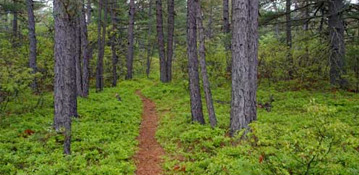Thousands of years ago, melting glaciers left extensive sand deposits between Ossipee Lake and Silver Lake, which once were a single body of water. Today, the state’s last viable pitch pine scrub oak barrens are found on these sandy soils.
 While colonial settlers found the soil at this site “barren,” meaning unsuitable for agriculture, it was superior for growing white pines and pitch pines. Markets were developed for both species in New England’s seaports.
While colonial settlers found the soil at this site “barren,” meaning unsuitable for agriculture, it was superior for growing white pines and pitch pines. Markets were developed for both species in New England’s seaports.
White pine grows fast, straight, and long. Since it’s strong, but relatively light and easy to work with, it was sold to shipbuilders for masts and spars. Pitch pine is twisted, brittle and difficult to work with. But its pitch was suitable for caulking boats.
While white pines were harvested, pitch pines were ‘scored’ in order to extract the pitch. That they were left standing is one of the reasons this unique forest ecosystem survives today as a 2,000-acre home to rare species of moths, butterflies and birds.
The Nature Conservancy owns the Ossipee Pine Barrens and maintains hiking trails that are accessible from three trailheads. In the summer, there are blueberries and the songs of whip-poor-wills at night. In the fall, the scrub oaks and blueberry bushes turn a brilliant scarlet and you’re likely to see foxes and deer.
For more information, including maps and parking information, check the Nature Conservancy’s NH website.
